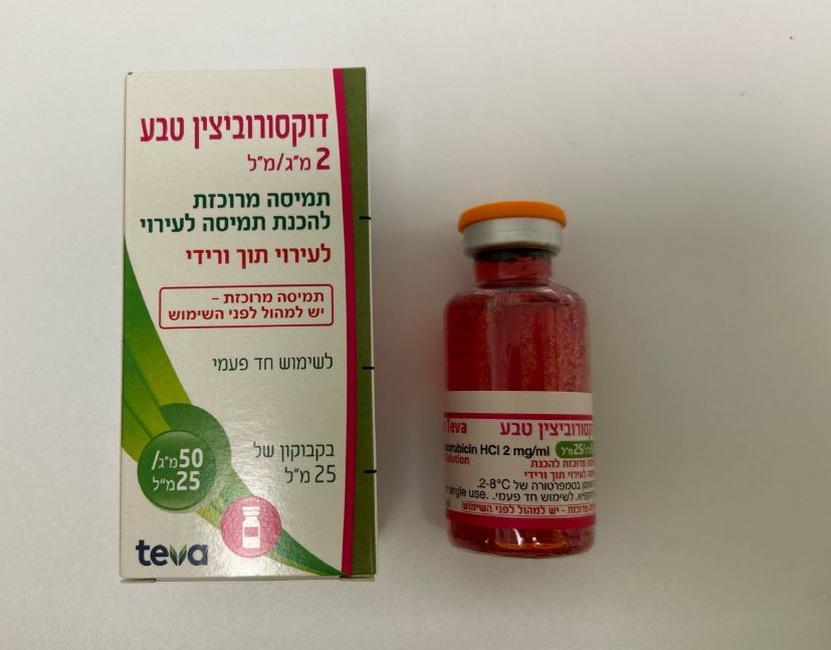Quest for the right Drug

דוקסורוביצין טבע DOXORUBICIN TEVA (DOXORUBICIN HYDROCHLORIDE)
תרופה במרשם
תרופה בסל
נרקוטיקה
ציטוטוקסיקה
צורת מתן:
תוך-ורידי : I.V
צורת מינון:
תרכיז להכנת תמיסה לאינפוזיה : CONCENTRATE FOR SOLUTION FOR INFUSION
עלון לרופא
מינוניםPosology התוויות
Indications תופעות לוואי
Adverse reactions התוויות נגד
Contraindications אינטראקציות
Interactions מינון יתר
Overdose הריון/הנקה
Pregnancy & Lactation אוכלוסיות מיוחדות
Special populations תכונות פרמקולוגיות
Pharmacological properties מידע רוקחי
Pharmaceutical particulars אזהרת שימוש
Special Warning עלון לרופא
Physicians Leaflet
Interactions : אינטראקציות
4.5 Interaction with other medicinal products and other forms of interaction Doxorubicin is a major substrate of cytochrome P450 CYP3A4 and CYP2D6, and P-glycoprotein (P- gp). Clinically significant interactions have been reported with inhibitors of CYP3A4, CYP2D6, and/or P-gp (e.g., verapamil), resulting in increased concentration and clinical effect of doxorubicin. Conversely, inducers of CYP3A4 (e.g., rifampicin, phenobarbital, phenytoin, St. John’s Wort) and of P-gp may decrease plasma levels of doxorubicin and may thus lead to a decrease in efficacy. Doxorubicin hydrochloride used in combination with cyclosporin might require dose-adjustment. At concomitant administration of cyclosporin, the clearance of doxorubicin is reduced by approximate 50%. The doxorubicin AUC is increased by 55% and AUC of doxorubicinol by 350%. With this combination a 40% dose reduction of doxorubicin is suggested. Cyclosporin inhibits, similar to verapamil, both CYP3A4 and P-glycoprotein, which might explain the interaction and resulting increase in adverse effects. Literature reports suggest that adding cyclosporine to doxorubicin results in more profound and prolonged haematologic toxicity than that observed with doxorubicin alone. Coma and seizures have also been described with concomitant administration of cyclosporine and doxorubicin. Cimetidine has also been shown to reduce the plasma clearance and increase the AUC of doxorubicin. Doxorubicin is mainly used in combination with other cytotoxic drugs. Additive toxicity may occur especially with regard to bone marrow/haematologic and gastrointestinal effects (see section 4.4). The use of doxorubicin in combination chemotherapy with other potentially cardiotoxic drugs (e.g., 5- fluorouracil, cyclophosphamide or paclitaxel), as well as the concomitant use of other cardioactive compounds (e.g., calcium channel blockers), require monitoring of cardiac function throughout treatment. Paclitaxel can cause increased plasma-concentrations of doxorubicin and/or its metabolites when given prior to doxorubicin. Certain data indicate that a smaller increase is observed when doxorubicin is administered prior to paclitaxel. The use of trastuzumab in combination with anthracyclines (such as doxorubicin) is associated with a high cardiotoxic risk. . Trastuzumab and anthracyclines should currently not be used in combination, except for well controlled clinical studies with monitoring of cardiac function (see section 4.4). (Pre-)treatment with drugs affecting the function of the bone marrow (e.g., cytostatic agents, sulfonamides, chloramphenicol, phenytoin, amidopyrine derivates, antiretroviral drugs) might lead to severe hematopoietic disturbances. The dosage of doxorubicin has to be changed if necessary. The toxic effects of a doxorubicin therapy may be increased in a combination with other cytostatics (e.g., cytarabine, cisplatin, cyclophosphamide). Necroses of the large intestine with massive haemorrhage and severe infections have been reported in combination therapies with cytarabine. Doxorubicin hepatotoxicity may be enhanced by other hepatotoxic treatment modalities (e.g., 6- mercaptopurine). Doxorubicin is a potent radiosensitizing agent (“radiosensitizer”), and recall phenomena induced by it may be life-threatening. Any preceding, concomitant or subsequent radiation therapy may increase the cardiotoxicity or hepatotoxicity of doxorubicin. Doxorubicin therapy may lead to increased serum uric acid, therefore dose adjustment of uric acid lowering agents may be necessary. Doxorubicin may reduce oral bioavailability of digoxin. The absorption of antiepileptic drugs (e.g., carbamazepine, phenytoin, valproate) is decreased after concomitant use of doxorubicin hydrochloride. During treatment with doxorubicin hydrochloride, patients should not be actively vaccinated and should also avoid contact with recently polio vaccinated persons. Doxorubicin binds to heparin and 5-fluorouracil. Precipitations and loss of action of both substances are therefore possible. See section 6.2 for more details. In a clinical study increase in doxorubicin AUC (21-47%) and no increase was observed when given with sorafenib 400 mg twice daily. The clinical significance of these findings is unknown.

שימוש לפי פנקס קופ''ח כללית 1994
לא צוין
תאריך הכללה מקורי בסל
01/01/1995
הגבלות
תרופה מוגבלת לשימוש בבתי חולים או אשפוז יום
מידע נוסף
